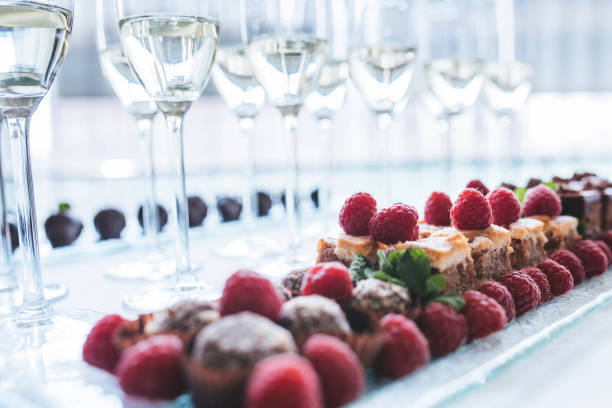Desserts and wines – a culinary pairing that has the power to create a harmonious symphony of flavors on your palate. When done right, the art of pairing desserts with wines elevates the dining experience, leaving you with a sweet memory that lingers long after the last bite.
The Basics of Pairing
Pairing desserts and wines is an intricate dance between the sweetness, acidity, and flavors of both elements. Here are some fundamental guidelines to consider when pairing:
1. Match Sweetness Levels: The wine should be as sweet as or sweeter than the dessert to ensure the wine doesn’t taste tart or bitter in comparison.
2. Consider Flavor Intensity: Balance the intensity of flavors. Light desserts work well with delicate wines, while rich desserts require more robust wines to complement them.
3. Harmonize Flavors: Look for complementary or contrasting flavors. For example, a citrusy wine can enhance the flavors of a lemon tart, while a chocolate dessert pairs beautifully with a red wine boasting dark fruit notes.
4. Factor in Texture: Pay attention to the dessert’s texture. Creamy desserts often benefit from sparkling wines, while light, fruity desserts may be enhanced by a crisp white wine.
Classic Pairings
Let’s explore some classic dessert and wine pairings that have stood the test of time:
1. Chocolate and Red Wine: The deep, complex flavors of dark chocolate are beautifully complemented by red wines with rich, fruity notes. A Cabernet Sauvignon or a Merlot pairs splendidly with a chocolate torte or a decadent chocolate mousse.
2. Fruit-Based Desserts and Moscato: Light, fruity desserts like a fruit tart or berry pavlova harmonize with a slightly sweet, sparkling Moscato. The wine’s natural sweetness enhances the fruit flavors.
3. Vanilla and Chardonnay: Vanilla desserts, such as a crème brûlée or panna cotta, are perfectly balanced with a creamy Chardonnay. The wine’s buttery notes elevate the dessert’s subtle vanilla undertones.
4. Citrus Desserts and Riesling: Lemon tarts, key lime pies, or citrus sorbets pair wonderfully with a crisp, slightly sweet Riesling. The wine’s acidity complements the citrus flavors.
5. Cheese and Port: The complex, nutty flavors of aged cheeses are enriched by the sweet, fortified wine known as Port. It’s a classic combination that provides a delightful contrast.
6. Tiramisu and Espresso Liqueur: Tiramisu’s coffee and cocoa notes find a perfect companion in espresso liqueur. The intense, aromatic flavors create a memorable dessert experience.
7. Apple Pie and Ice Wine: The warm, spiced notes of apple pie find their match in an ice wine with its concentrated, honeyed sweetness. The contrast elevates both dessert and wine.
Exploring Contrasts
While classic pairings provide a solid foundation, experimenting with contrasting pairings can lead to delightful discoveries:
1. Sweet and Savory Pairings: Combining sweet desserts with savory wines creates a delightful contrast. Try a sweet Riesling with salty, blue cheese-stuffed dates or a sparkling wine with a salty caramel dessert.
2. Spicy and Sweet Pairings: Spicy desserts, such as cinnamon-infused pastries or spicy chocolate, can be balanced with a sweet, fruity wine like a Gewürztraminer or a Zinfandel.
3. Creamy and Fizzy Pairings: Creamy desserts like cheesecake can be enlivened with a sparkling wine, such as Prosecco or Champagne, which adds a refreshing effervescence.
Art of Presentation
The art of pairing desserts and wines extends to the presentation. Consider the following elements:
1. Temperature: Ensure that the wine and dessert are served at the appropriate temperatures. Chilled desserts should be paired with chilled wines, and room temperature desserts pair well with wines at a slightly cooler temperature.
2. Glassware: Serve wine in the appropriate glassware that complements its style. Dessert wines often call for smaller, tulip-shaped glasses to concentrate their aromas.
3. Garnishes: Garnish your dessert with elements that enhance the pairing. A sprig of mint, a drizzle of caramel, or a dusting of cocoa powder can accentuate the flavors.
4. Dessert Wine Glasses: Consider investing in dessert wine glasses designed to highlight the wine’s characteristics. For example, the smaller size of a Port glass is tailored to the wine’s intense flavors.
The key to a successful dessert and wine pairing is balance. It’s about creating an experience where neither the dessert nor the wine overpowers the other. When done right, it’s like a sweet symphony on your palate, where every note plays in harmony.
The next time you indulge in a delectable dessert, raise your glass to the art of pairing and savor the sweet symphony that unfolds on your palate.
